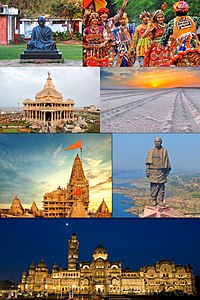
Photo from wikipedia
Abstract Globally natural and human interference is affecting aquifer recharge and quality of ground water. This study focuses on changes in groundwater hydrochemistry in south and central part of Gujarat… Click to show full abstract
Abstract Globally natural and human interference is affecting aquifer recharge and quality of ground water. This study focuses on changes in groundwater hydrochemistry in south and central part of Gujarat state in India to identify vulnerable hotspots under seasonal variations and anthropogenic activities. Forty-five groundwater and soil samples were collected over three seasons from random locations of south and central Gujarat. The samples were analyzed for physico-chemical characteristics. Dominance of cations and anions during post-monsoon was in higher to lower order of Na, Mg, Ca, K and Cl−, SO42−, HCO3− in groundwater. The Piper classification for hydrogeochemical facies indicates all monsoon samples were of Ca–Cl type. Residual sodium carbonate values revealed that 46% samples were not suitable for irrigation purposes in pre-monsoon. Samples collected during post-monsoon from Vyara and Ukai and during pre-monsoon from Central Gujarat were of doubtful to unsuitable category as per Wilcox's diagram. During the post-monsoon season, moderate and bad quality water rose owing to the enrichment of sodium and electrical conductivity. The groundwater quality in post-monsoon for all constituents were higher at some places due to dissolution of surface pollutants and infiltration after flooding with percolation of rainwater. None of the samples from pre-monsoon fell under Class-I category (Permeability index >75%) due to leaching of ions through industrial, agricultural or domestic discharges. Soil permeability index varied from monsoon to post- and pre-monsoon. Groundwater quality of Vadodara, Bharuch, and Tapi districts were affected by geological and anthropogenic activities while ground water in Vansda and Ahwa were less affected due to limited industrialization as well as geographical location. The cumulative hydrochemistry during post- and pre-monsoon was found to be higher than permissible limits due to leaching of contaminants. Judicious management of efficient irrigation, industrial waste treatment, modern agricultural practices, rainwater harvesting to conserve groundwater quality of study area are critical.
Journal Title: Groundwater for Sustainable Development
Year Published: 2020
Link to full text (if available)
Share on Social Media: Sign Up to like & get
recommendations!